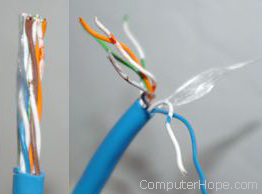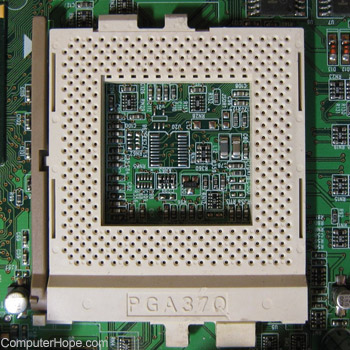What is the difference between a connector, jack, plug, and port?
Plug
 The plug is part of a cable that connects to a port. The plug always connects to something else (e.g., a jack or port). For example, the most common plug is the power plug that connects your computer, monitor, and other devices to a power source. The picture is a desktop power cord in the United States with a male plug end that connects to the wall socket and the female plug end that connects to the computer or monitor.
The plug is part of a cable that connects to a port. The plug always connects to something else (e.g., a jack or port). For example, the most common plug is the power plug that connects your computer, monitor, and other devices to a power source. The picture is a desktop power cord in the United States with a male plug end that connects to the wall socket and the female plug end that connects to the computer or monitor.
Note: In our example of a power cord plug, this plug is different in different countries around the world.
Cable and Cord
 A cable or cord is one or more wires in a plastic covering that allows for the transmission of power or data between devices. In the picture to the right is an example of a CAT5 network cable. See our cabledefinition for a list of types of cables that are used with computers.
A cable or cord is one or more wires in a plastic covering that allows for the transmission of power or data between devices. In the picture to the right is an example of a CAT5 network cable. See our cabledefinition for a list of types of cables that are used with computers.
Wire
A wire is a single strand of metal (e.g., copper) or optical fibers capable of transmitting power or data from one area to another.
Connector
A connector is the unique end of a plug, jack, or the edge of a card that connects to a port. For example, all desktop computer expansion cards have a connector that allows them to connect in a slot on the motherboard. When referring to cables, the connector is the end of the cable that connects into a port. For example, the end of a USB cable has a connector that allows it to connect to a USB port.
Port
 The port has either holes or a slot that matches the plug or card being connected to the port. The picture shows an example of a PS/2 port found on the back of computers that allows a keyboard and mouse with a PS/2 connector to connect to the computer.
The port has either holes or a slot that matches the plug or card being connected to the port. The picture shows an example of a PS/2 port found on the back of computers that allows a keyboard and mouse with a PS/2 connector to connect to the computer.
Note: There are also software ports, for example, port 80 is a network port that allows HTTP traffic on a network.
- See our port definition for a full listing of computer ports.
Jack
A jack is similar to a port and is a hole or other connection that allows a compatible plug to be connected to the jack. With computers, a jack is usually used to describe an audio jack.
Adapter
An adapter is a device capable of converting power or data from one source of input to into another. For example, an AC adapter used with laptop computers and other devices takes AC power and converts it into DC power.
Socket
 A socket is an opening that is designed to fit another device. A perfect example of a socket with a computer is a CPU socket, which is a socket on the motherboard that allows a CPU to connect to the computer.
A socket is an opening that is designed to fit another device. A perfect example of a socket with a computer is a CPU socket, which is a socket on the motherboard that allows a CPU to connect to the computer.
Over the evolution of computers, there have been many different sockets designed for computers. Each socket supports a set of computer processors. For example, the Socket 370 is a socket that supported the first Intel Celeron processors and Coppermine processors.
Slot
A slot is also a connection used with computers that can either describe a CPU slot or an expansion slot. Today, CPU sockets are used instead of CPU slots, but expansion slots are still used to connect expansion cards to the computer.
Comments
Post a Comment